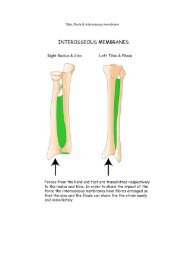GSM 11.14 - Version 5.2.0 - Digital cellular ... - Ttfn.net
GSM 11.14 - Version 5.2.0 - Digital cellular ... - Ttfn.net
GSM 11.14 - Version 5.2.0 - Digital cellular ... - Ttfn.net
Create successful ePaper yourself
Turn your PDF publications into a flip-book with our unique Google optimized e-Paper software.
Page 17<br />
<strong>GSM</strong> <strong>11.14</strong> version <strong>5.2.0</strong>: December 1996<br />
When text is to be explicitly displayed by the ME, a flag shall be set to inform the ME if it should clear the<br />
message and return to what was present previously after a short delay (the duration of the delay being at<br />
the discretion of the ME manufacturer), or whether the message shall remain on the display until the user<br />
clears it. The first instance would normally only be used where it is expected that the user is already<br />
looking at the display.<br />
NOTE: For the case where the text is cleared after a short delay, the ME may also allow the<br />
user to clear the display via the MMI prior to this.<br />
The ME shall reject normal priority text commands if the screen is currently being used for more than its<br />
normal stand-by display. If the command is rejected, the ME informs the SIM using TERMINAL<br />
RESPONSE (ME currently unable to process command - screen busy).<br />
High priority text must be displayed on the screen immediately.<br />
6.4.2 GET INKEY<br />
This command instructs the ME to display text, and to expect the user to enter a single character. Any<br />
response entered by the user shall be passed transparently by the ME to the SIM.<br />
The text can be in one of two formats:<br />
- packed format;<br />
- unpacked format.<br />
The response can be from one of two character sets. This is specified by the SIM:<br />
- digits only (0-9, *, #, and +);<br />
- characters from the SMS default alphabet.<br />
Upon receiving the command, the ME shall display the text. The ME shall allow the user to enter a single<br />
character in response.<br />
- If the user presses END (or otherwise declines to respond, e.g. CLEAR), the ME shall give a null<br />
text string to the SIM, using TERMINAL RESPONSE.<br />
- If the SIM requests a digit only, the ME shall only allow the user to enter a character from the<br />
digits 0-9, *, # and +. When the user has entered a digit, the ME shall pass the entered digit<br />
transparently to the SIM, using TERMINAL RESPONSE.<br />
- If the SIM requests a character from the SMS default alphabet, the ME shall allow the user to enter<br />
a character using characters from this alphabet. When the user has entered a character, the ME<br />
shall pass the entered character transparently to the SIM, using TERMINAL RESPONSE.<br />
NOTE: If the MMI of the ME requires more than one keypress in order to select a character, it<br />
is an implementation decision for the ME manufacturer how to indicate completion (e.g.<br />
timeout, pressing SEND, OK). It may be useful to echo the input character on the<br />
display.<br />
For both character sets, the response shall be coded using the SMS default alphabet in unpacked format.<br />
6.4.3 GET INPUT<br />
This command instructs the ME to display text, and that any response string entered by the user shall be<br />
passed transparently by the ME to the SIM.<br />
The text can be in one of two formats:<br />
- packed format;<br />
- unpacked format.








